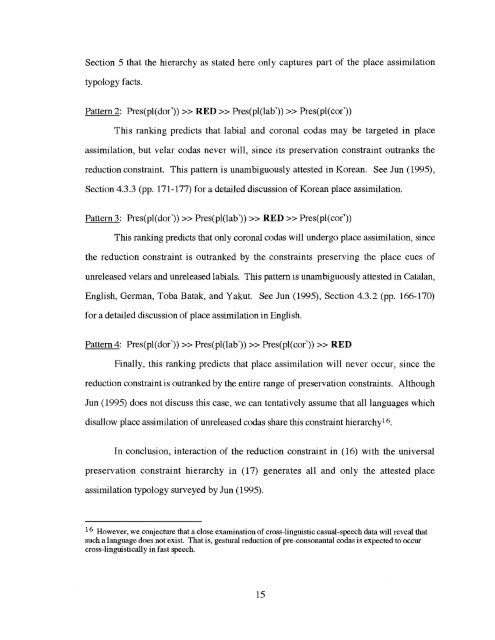A Phonetically-Based Optimality Theoretic Account of Consonant ...
A Phonetically-Based Optimality Theoretic Account of Consonant ...
A Phonetically-Based Optimality Theoretic Account of Consonant ...
You also want an ePaper? Increase the reach of your titles
YUMPU automatically turns print PDFs into web optimized ePapers that Google loves.
Section 5 that the hierarchy as stated here only captures part <strong>of</strong> the place assimilation<br />
typology facts.<br />
Pattern 2: Pres(pl(dor'»» RED» Pres(pl(1ab'»» Pres(pl(cor'»<br />
This ranking predicts that labial and coronal codas may be targeted in place<br />
assimilation, but velar codas never will, since its preservation constraint outranks the<br />
reduction constraint. This pattern is unambiguously attested in Korean. See Jun (1995),<br />
Section 4.3.3 (pp. 171-177) for a detailed discussion <strong>of</strong> Korean place assimilation.<br />
Pattern 3: Pres(pl(dor'»» Pres(pl(1ab'»» RED» Pres(pl(cor'»<br />
This ranking predicts that only coronal codas will undergo place assimilation, since<br />
the reduction constraint is outranked by the constraints preserving the place cues <strong>of</strong><br />
unreleased velars and unreleased labials. This pattern is unambiguously attested in Catalan,<br />
English, German, Toba Batak, and Yakut. See Jun (1995), Section 4.3.2 (pp. 166-170)<br />
for a detailed discussion <strong>of</strong> place assimilation in English.<br />
Pattern 4: Pres(pl(dor'»» Pres(pl(1ab'»» Pres(pl(cor'»» RED<br />
Finally, this ranking predicts that place assimilation will never occur, since the<br />
reduction constraint is outranked by the entire range <strong>of</strong> preservation constraints. Although<br />
Jun (1995) does not discuss this case, we can tentatively assume that all languages which<br />
disallow place assimilation <strong>of</strong> unreleased codas share this constraint hierarchy16.<br />
In conclusion, interaction <strong>of</strong> the reduction constraint in (16) with the universal<br />
preservation constraint hierarchy in (17) generates all and only the attested place<br />
assimilation typology surveyed by Jun (1995).<br />
16 However, we conjecture that a close examination <strong>of</strong> cross-linguistic casual-speech data will reveal that<br />
such a language does not exist. That is, gestural reduction <strong>of</strong> pre-consonantal codas is expected to occur<br />
cross-linguistically in fast speech.<br />
15
















